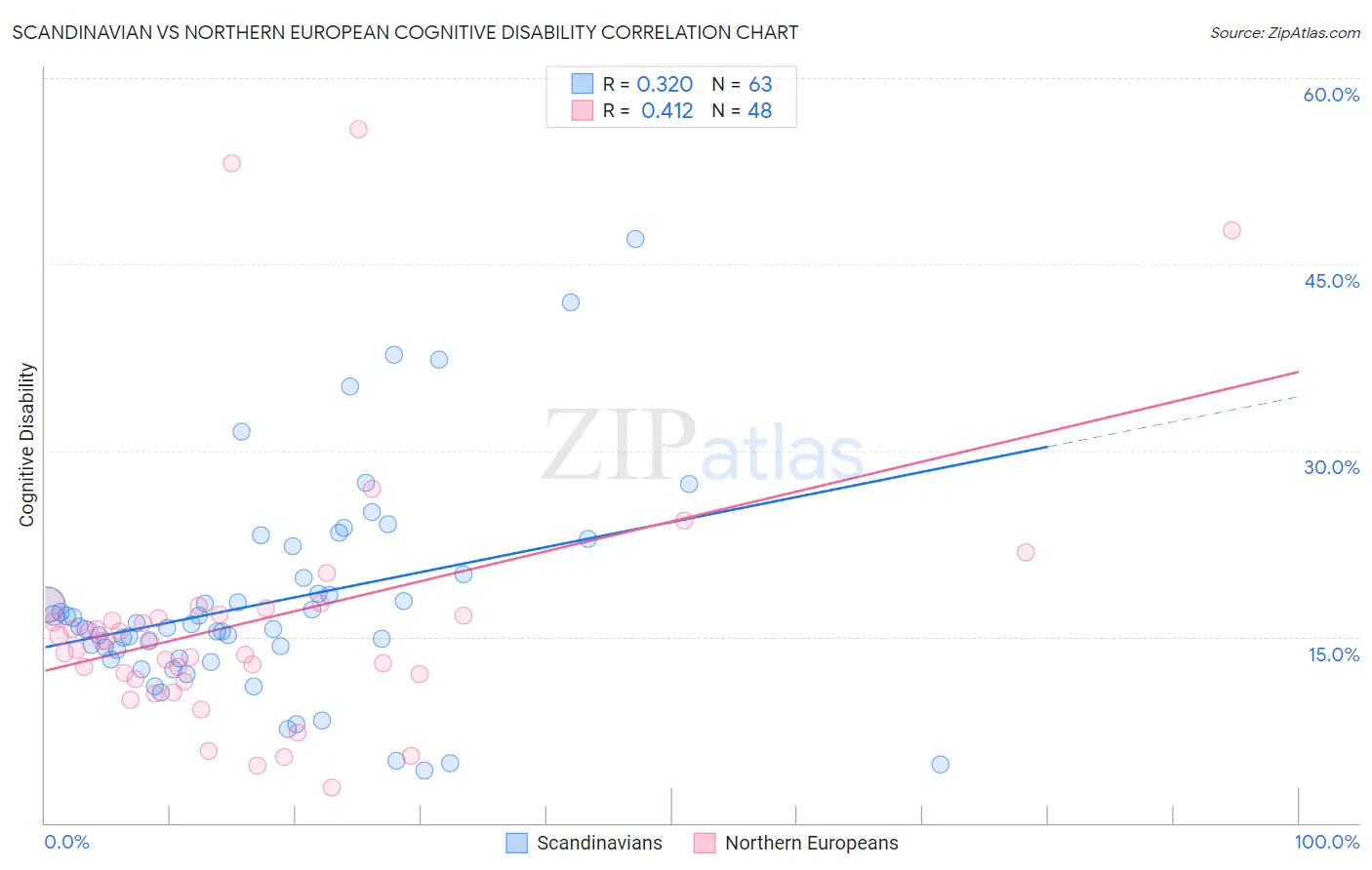Scandinavian vs Northern European Cognitive Disability
COMPARE
Scandinavian
Northern European
Cognitive Disability
Cognitive Disability Comparison
Scandinavians
Northern Europeans
16.9%
COGNITIVE DISABILITY
94.1/ 100
METRIC RATING
125th/ 347
METRIC RANK
16.8%
COGNITIVE DISABILITY
97.8/ 100
METRIC RATING
106th/ 347
METRIC RANK
Scandinavian vs Northern European Cognitive Disability Correlation Chart
The statistical analysis conducted on geographies consisting of 472,549,780 people shows a mild positive correlation between the proportion of Scandinavians and percentage of population with cognitive disability in the United States with a correlation coefficient (R) of 0.320 and weighted average of 16.9%. Similarly, the statistical analysis conducted on geographies consisting of 406,047,149 people shows a moderate positive correlation between the proportion of Northern Europeans and percentage of population with cognitive disability in the United States with a correlation coefficient (R) of 0.412 and weighted average of 16.8%, a difference of 0.75%.

Cognitive Disability Correlation Summary
| Measurement | Scandinavian | Northern European |
| Minimum | 4.2% | 2.8% |
| Maximum | 47.1% | 55.9% |
| Range | 42.9% | 53.1% |
| Mean | 17.8% | 16.2% |
| Median | 15.8% | 14.7% |
| Interquartile 25% (IQ1) | 13.3% | 11.8% |
| Interquartile 75% (IQ3) | 20.0% | 16.7% |
| Interquartile Range (IQR) | 6.7% | 4.9% |
| Standard Deviation (Sample) | 8.6% | 10.6% |
| Standard Deviation (Population) | 8.5% | 10.4% |
Demographics Similar to Scandinavians and Northern Europeans by Cognitive Disability
In terms of cognitive disability, the demographic groups most similar to Scandinavians are Turkish (16.9%, a difference of 0.050%), Portuguese (16.9%, a difference of 0.080%), Immigrants from Western Europe (16.9%, a difference of 0.090%), Immigrants from China (16.9%, a difference of 0.10%), and Scottish (16.9%, a difference of 0.12%). Similarly, the demographic groups most similar to Northern Europeans are Immigrants from Nicaragua (16.8%, a difference of 0.020%), Immigrants from Eastern Asia (16.8%, a difference of 0.040%), Canadian (16.8%, a difference of 0.11%), Albanian (16.8%, a difference of 0.16%), and Arapaho (16.8%, a difference of 0.17%).
| Demographics | Rating | Rank | Cognitive Disability |
| Immigrants | Eastern Asia | 97.9 /100 | #105 | Exceptional 16.8% |
| Northern Europeans | 97.8 /100 | #106 | Exceptional 16.8% |
| Immigrants | Nicaragua | 97.8 /100 | #107 | Exceptional 16.8% |
| Canadians | 97.5 /100 | #108 | Exceptional 16.8% |
| Albanians | 97.3 /100 | #109 | Exceptional 16.8% |
| Arapaho | 97.3 /100 | #110 | Exceptional 16.8% |
| Uruguayans | 97.2 /100 | #111 | Exceptional 16.8% |
| Indians (Asian) | 97.2 /100 | #112 | Exceptional 16.8% |
| Immigrants | Sri Lanka | 97.1 /100 | #113 | Exceptional 16.8% |
| Koreans | 97.1 /100 | #114 | Exceptional 16.8% |
| Yup'ik | 96.9 /100 | #115 | Exceptional 16.9% |
| Inupiat | 96.5 /100 | #116 | Exceptional 16.9% |
| Immigrants | Japan | 96.2 /100 | #117 | Exceptional 16.9% |
| Immigrants | Denmark | 96.2 /100 | #118 | Exceptional 16.9% |
| South Africans | 95.5 /100 | #119 | Exceptional 16.9% |
| Scottish | 95.0 /100 | #120 | Exceptional 16.9% |
| Immigrants | China | 94.9 /100 | #121 | Exceptional 16.9% |
| Immigrants | Western Europe | 94.8 /100 | #122 | Exceptional 16.9% |
| Portuguese | 94.7 /100 | #123 | Exceptional 16.9% |
| Turks | 94.5 /100 | #124 | Exceptional 16.9% |
| Scandinavians | 94.1 /100 | #125 | Exceptional 16.9% |